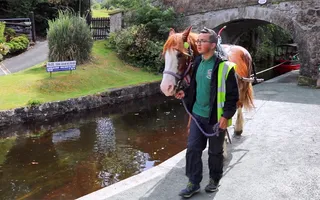What is less well-known is that they also hauled narrowboats laden with freight.
Horseboating
For hundreds of years, horses were the backbone of British industry. They ploughed fields and pulled carts, carriages and charabancs all over the country.

We are all familiar with the term 'horsepower', and the notion that a horse can pull many times its own body weight. However, a horse can move almost 50 times more weight in a boat than it could in a cart on old-fashioned roads.
A horse pulling a boat or barge wastes minimal energy through friction, and it is this efficiency calculation which led to the development of Britain's canal system in the 18th century.
The canal age reigned supreme until the advent of the railways revolutionised the transport industry. But the simple and romantic practice of horseboating continued in Britain until the mid-1960s – lasting almost 200 years.
Horseboating - nuts & bolts

It may appear slow and laborious, but horseboating was hard work and thorough knowledge of the canals was essential. Boatmen had generations of skill in boat and horse handling to draw on. The entire infrastructure of the waterways was built for the horsedrawn era, with smooth curves on bridges and buildings (to avoid snagging towlines), well-maintained and unobstructed towpaths and a wealth of canal furniture to help horseboats go smoothly.
The boatmen also relied on tools such as forethought, 'smacking whips' and 'strapping posts'.
Forethought: Horseboats do not have brakes and the act of stopping a boat loaded with cargo took a supreme effort. This came from knowledge of the canals and experience of where boats were likely to meet with obstacles such as lock gates or boats coming the opposite way.
Smacking whips: As barbaric as the name sounds, smacking whips were not used to punish the horse, but to create a loud 'smacking' noise, like a gunshot, to warn of the boat's approach.
Strapping posts: These were commonly made of wood or iron and set in the ground close enough to the canal for the boatman to wrap the 'strap' around them. The 'strap' was simply a strong piece of rope attached to the boat, which, after being wound around the post, would slow the boat down or, at junctions or sharp bends, allow it to change direction.
Horseboating today
The practice of horseboating over the national waterway network continues thanks to organisations such as the horseboating society, although permission must be obtained before you take a horseboat onto the waterways.
Last Edited: 13 March 2024


Stay connected
Sign up to our newsletter and discover how we protect canals and help nature thrive


